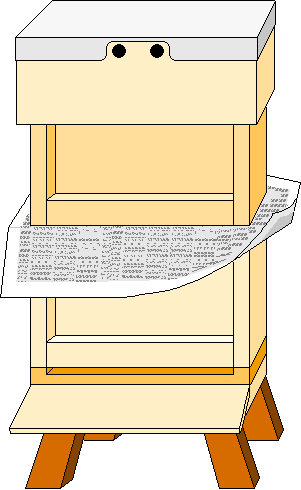The "newspaper method"

The "newspaper method" is the most common method of uniting two or more boxes of unrelated bees.
One or two sheets of newspaper are placed between the boxes of bees to act as a barrier which will slow down the integration of the two groups of bees. The newspaper is pricked a few times in the area over the centre of the box. This will give the bees a purchase to start the chewing, which will gradually open a passage which bees can pass through.
This chewing takes time and during it, bees from either side of the membrane have an opportunity to lick each other, allowing scents to mingle. Very little fighting normally occurs, although on odd occasions fighting results in the deaths of many bees. Luckily such occasions are so rare that I have only seen it once in a thirty year period and I am one that has taken a few chances.
Leave the united bees alone for a week, they will have removed most of the newspaper and it will be seen as scattered fragments in front of the hive entrance.
A queenless or weak colony may be united with another. Put the weaker colony on top of the stronger one. Many texts will tell you to kill the least desirable queen in one of the two groups to be united, but I find it is often prudent to leave both queens, so that the bees can make the choice, in most cases the younger and fitter queen remains, but there may be subtle things in a queen's make up that the bees are better able to make choices about rather than the beekeeper.
There is a variation to this method... If the lower colony already has a honey super on, this can be left in place and the newspaper positioned on top of the super, rather than the brood box.
Yet another variation is to use one or two queen excluders, so that the bees unite, but the queens cannot meet. If the upper box does not contain frames, a swarm may be dumped into it. In either case the queen from the upper box will be found on the upper surface of the topmost queen excluder after most of the bees have gone through the newspaper.
D.A.C.
The "Uniting Bees" page (button top left) should be read in conjunction with this one. Some sources will suggest that uniting should be performed in the evening. It can, but I have never found it necessary. One thing that isn't often mentioned is to remove all empty hive parts from the surrounding area. This avoids confusion and I find the bees settle down quicker.
I use 2-3 thicknesses of newspaper, otherwise, there is a chance that brace comb may puncture a single sheet when the top box is put on the bottom one. The paper should only have a small hole, such as from a frame nail, or a narrow slit from a sharp knife. The great gashes I have seen from blunt hive tools are far too large and may mean the bees meeting each other too early and fighting. You only need a few holes, not like a dartboard. An alternative to making holes is to smear the newspaper with honey or nectar. Quite frankly, I don't think any holes are necessary anyway.
Beekeepers are often advised to place a queen excluder over the newspaper to confine the queen to one box. I don't see the point of this, although it helps prevent the newspaper from blowing away on a windy day.
I have united many colonies using the newspaper method and had few problems. I have found it doesn't matter whether the queen is in the top or bottom box, but I think it is better to have the stronger colony on the bottom.
When uniting small colonies using two brood boxes, it is advisable to place the bees in the top box above those in the bottom box. You can close them down with dummy frames or division boards if you wish, but I have never bothered. R.P.
Originally written by Dave Cushman. Edited and additions by Roger Patterson.
Page created pre-2011
Page updated 21/12/2022